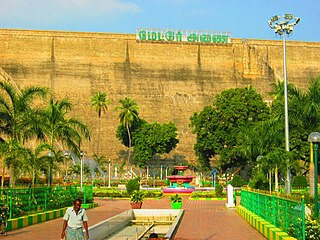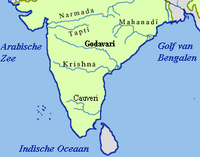
Kaveri, is an Indian river flowing through the states of Karnataka and Tamil Nadu. It is the third largest after Godavari and Krishna in south India and the largest in Tamil Nadu which on its course, bisects the state into North and South. Originating in the foothills of Western Ghats at Talakaveri, Kodagu in Karnataka it flows generally south and east through Karnataka and Tamil Nadu and across the southern Deccan plateau through the southeastern lowlands, emptying into the Bay of Bengal through two principal mouths in Poompuhar, Tamil Nadu. Amongst the river valleys, the Kaveri delta forms one of the most fertile regions in the country.

Krishna Raja Sagara, also popularly known as KRS, is a lake and the dam that creates it. They are close to the settlement of Krishnarajasagara in the Indian State of Karnataka. The gravity dam made of surki mortar is below the confluence of river Kaveri with its tributaries Hemavati and Lakshmana Tirtha, in the district of Mandya.

Palar is a river of southern India. It rises in the Nandi Hills in Chikkaballapura district of Karnataka state, and flows 93 kilometres (58 mi) in Karnataka, 33 kilometres (21 mi) in Andhra Pradesh and 222 kilometres (138 mi) in Tamil Nadu before reaching its confluence into the Bay of Bengal at Vayalur about 100 kilometres (62 mi) south of Chennai. It flows as an underground river for a long distance only to emerge near Bethamangala town, from where, gathering water and speed, it flows eastward down the Deccan Plateau. The cities of Ramanaickenpet, Vaniyambadi, Ambur, Melpatti, Gudiyatham, Pallikonda, Melmonavoor, Vellore, Melvisharam, Arcot, Ranipet Walajapet (Anaicut), Kanchipuram, and Chengalpattu are located on the banks of the Palar River. Of the seven tributaries, the chief tributary is the Cheyyar River.

The Mettur Dam is one of the largest dams in India and the largest in Tamil Nadu, located across the river Cauvery where it enters the plains. Built in 1934, it took 9 years to complete. Maximum height and width of the dam are 214 and 171 feet respectively. The dam receives inflows from its own catchment area, Kabini Dam and Krishna Raja Sagara Dams located in Karnataka. There is a park at the base of the dam called Ellis Park maintained by the Tamil Nadu Public Works Department. It provides irrigation and drinking water facilities for more than 12 districts of Tamilnadu and hence is revered as the life and livelihood-giving asset of Tamil Nadu

The Godavari River has its catchment area in seven states of India: Maharashtra, Telangana, Chhattisgarh, Madhya Pradesh, Andhra Pradesh, Karnataka and Odisha. The number of dams constructed in Godavari basin is the highest among all the river basins in India. Nearly 350 major and medium dams and barrages had been constructed in the river basin by the year 2012.

Nizam Sagar Dam is an Indian dam. It is a reservoir constructed across the Manjira River, a tributary of the Godavari River, between Achampet and BanjePally villages of the Kamareddy district in Telangana, India. It is located at about 144 km north-west of Hyderabad. Nizam Sagar is the oldest dam in the state of Telangana.

The Almatti Dam is a hydroelectric project on the Krishna River in North Karnataka, India which was completed in July 2005. The target annual electric output of the dam is 560 MU.

The Priyadarshini Jurala Project (PJP) or Jurala Project, is situated about 15 km from Gadwal, Jogulamba Gadwal district, Telangana, India. The Kurvapur Kshetra River is merging with water of the Joorala Project.

Honnihalli is a village in Belagavi district in the southern state of Karnataka, India.

Renuka Sagara, also known as Malaprabha reservoir and Navilutheertha reservoir, is a dam and impounding reservoir constructed across the Malaprabha River in the Krishna River basin. It is situated at Navilatirtha village in Savadatti Taluk Taluk of Belgaum district in North Karnataka, India. The dam with the height of 43.13 metres and 4 Vertical Crest Gates, impounds a large reservoir with a gross surface area of 54.97 Square kilometres, and storage capacity of 37.73 Tmcft. It is an earthen and masonry dam which caters to the Irrigation needs for over 5,40,000 acres, and Hydel power generation.

The Bhadra Dam, which has created the Bhadra Reservoir, is located on the Bhadra River a tributary of Tungabhadra River. Bhadra dam is located in the border of Bhadravathi and Tarikere, in the western part of Karnataka in India. The benefits derived from the reservoir storage are irrigation with gross irrigation potential of 162,818 hectares, hydro power generation of 39.2 MW, drinking water supply and industrial use. The dam commissioned in 1965 is a composite earth cum masonry structure of 59.13 metres (194.0 ft) height with length of 1,708 metres (5,604 ft) at the crest level, which submerges a land area of 11,250.88 hectares.
Kosasthalaiyar River, also known as Kortalaiyar, is one of the three rivers that flow in the Chennai metropolitan area.

The Tungabhadra Dam also known as Pampa Sagar is constructed across the Tungabhadra River, a tributary of the Krishna River. The dam is in Munirabad, Koppal district of Karnataka. It is a multipurpose dam serving irrigation, electricity generation, flood control, etc. This is a joint project of erstwhile Hyderabad state and erstwhile Madras Presidency when the construction was started; later it became a joint project of Karnataka and Andhra Pradesh after its completion in 1953. The main architect of the dam was Dr Thirumala Iyengar, an engineer from Madras. There is a dispute between Andhra Pradesh,Telangana and Karnataka for the water of Tungabhadra reservoir. The main contractor for the dam was Venkat Reddy Mulamalla, from Konour village, Mahabubnagar, Hyderabad state.

The Pazhassi Dam also called Kulur Barrage is a stone masonry diversion structure in Kannur district, Kerala, India. It is named after king Pazhassi Raja, a local warrior. The dam is constructed across the west flowing Valapattanam River near VELIYAMBRA. It was commissioned by Prime Minister Morarji Desai in 1979. It mainly functions as an irrigation dam, serving a command area of 11,525 hectares in Thalassery and Thaliparambra taluks of the Kannur District. The water from this dam also meets the drinking water requirement of Kannur district. The dam site and the reservoir are famous for their scenic beauty.

Government of India (GoI) constituted a common tribunal on 10 April 1969 to adjudicate the river water utilization disputes among the river basin states of Godavari and Krishna rivers under the provisions of Interstate River Water Disputes Act – 1956. The common tribunal was headed by Sri RS Bachawat as its chairman with Sri DM Bhandari and Sri DM Sen as its members. Godavari river basin is spread in the states of Telangana (TS), Maharashtra (MR), Orissa, old Madhya Pradesh {later bifurcated into present Madhya Pradesh (MP) and Chhattisgarh}, Karnataka (K) and Andhra Pradesh (AP). Krishna river basin states Maharashtra, Karnataka and Andhra Pradesh insisted on the quicker verdict as it had become more expedient for the construction of irrigation projects in Krishna basin. So the proceedings of Godavari Water Disputes Tribunal (GWDT) could not start till the Krishna Water Disputes Tribunal final verdict was submitted to GoI on 27 May 1976.
Raja Lakhamagouda Sardesai (1864–1942) was a philanthropist, provincial ruler of Vantamuri in Belagavi district. He was the 16th ruler of Vantamuri province. He ascended the throne at the age of 13 years in 1877. The province had a wada (palace) at Vantamuri which was built by Prabhu Basavantrao and it was submerged in 1978-79 when a dam was built downstream at Hidkal.

















